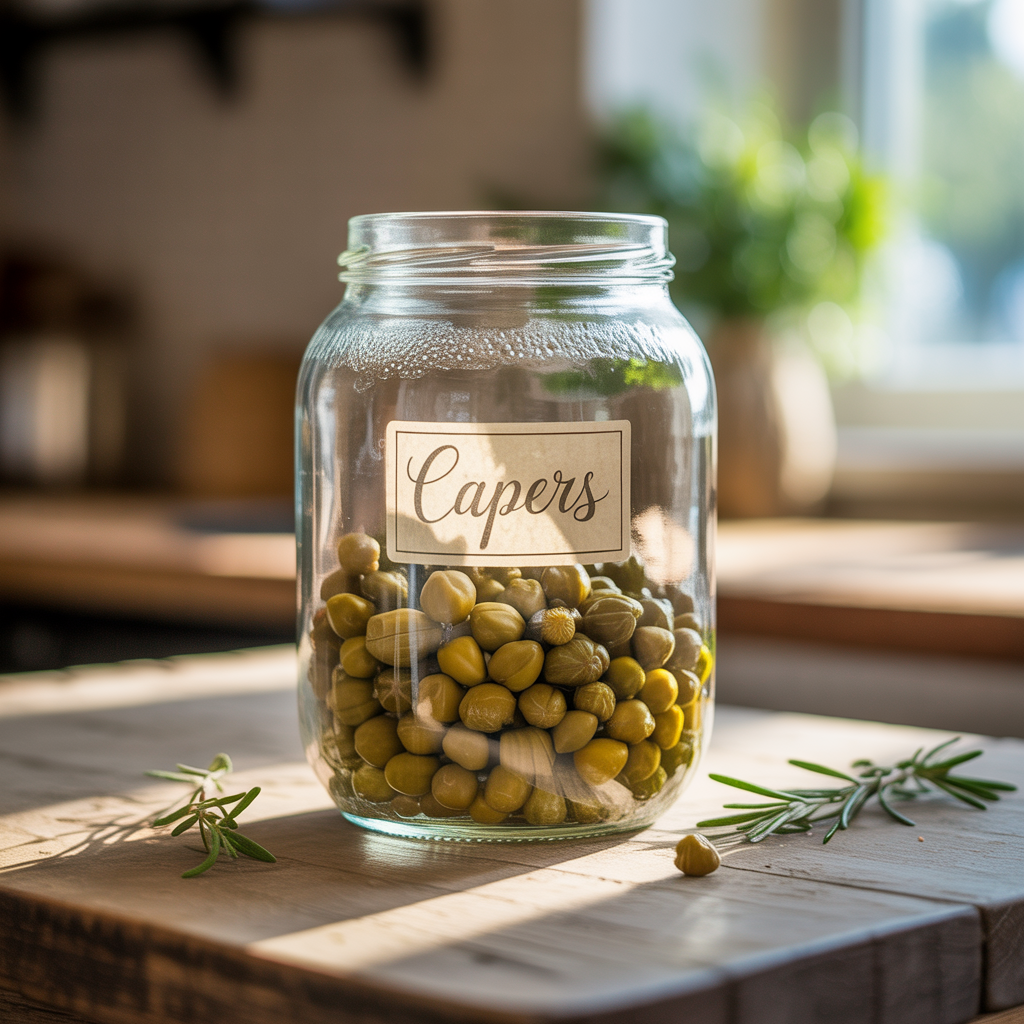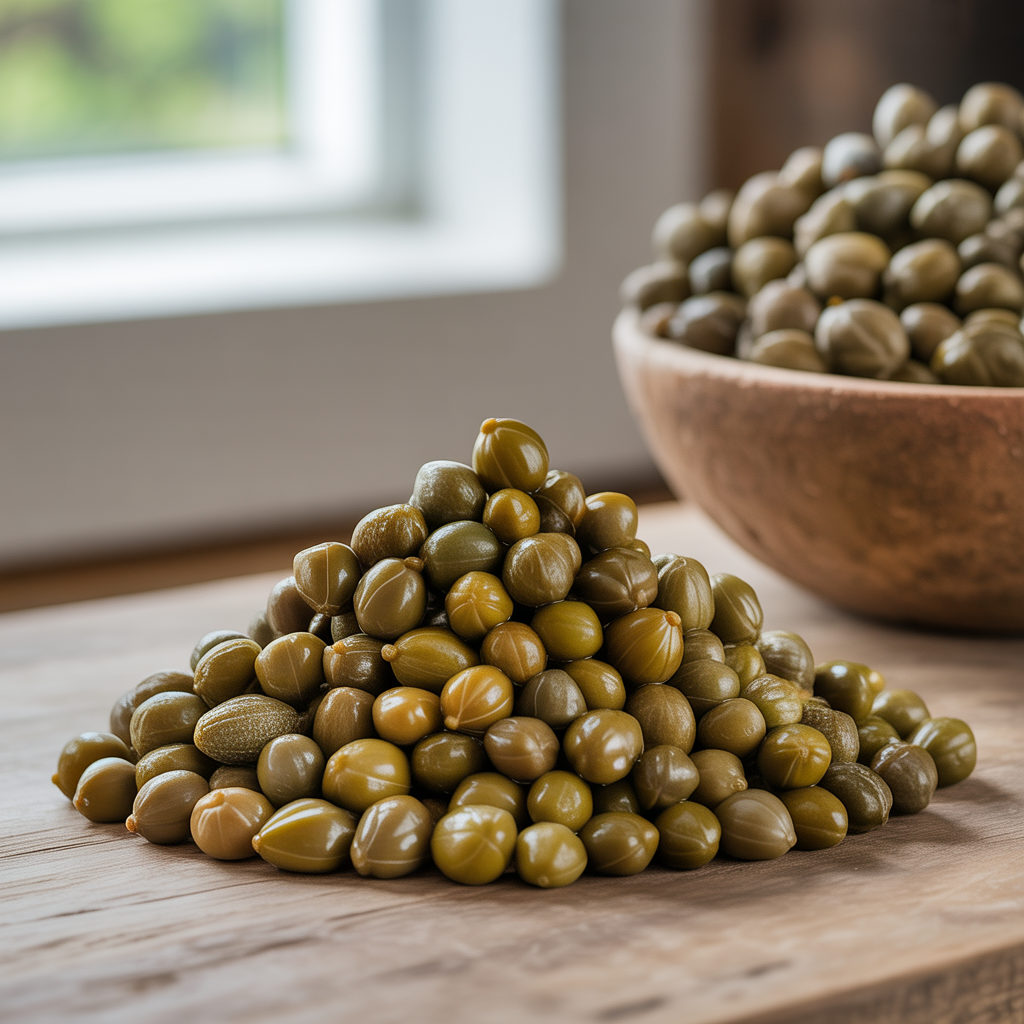What Are Capers? The Tiny Flavor Bombs That Transform Mediterranean Cuisine

Plot twist: Those small green buds in your chicken piccata aren’t peas or olives—they’re actually flower buds that never got the chance to bloom. According to recent research from the University of Wisconsin, capers are one of the most misunderstood ingredients in modern cooking, yet they deliver an unmatched flavor profile that elevates countless Mediterranean dishes.
[Pickled capers in a glass jar]
Whether you’ve spotted them in fancy restaurants or have a mysterious jar hiding in your refrigerator, understanding capers unlocks a world of culinary possibilities. Here’s everything you need to know about these tiny flavor powerhouses.
What Are Capers Made Of?
Capers are the unopened flower buds of the Capparis spinosa plant, commonly known as the caper bush or Flinders rose. This perennial plant is native to the Mediterranean region and parts of Asia, where it thrives in harsh, arid conditions, often growing wild from cracks in rocky cliffs and old stone walls.
When left to develop naturally, these buds would eventually bloom into beautiful whitish-pink flowers with distinctive purple stamens. However, for culinary purposes, the buds are harvested before they can flower, typically when they’re still dark green and about the size of a corn kernel.
As our deep dive into longevity strategies through Mediterranean foods revealed, capers aren’t just flavorful—they’re packed with beneficial compounds that contribute to the health benefits of Mediterranean cuisine.
From Bush to Jar: The Caper Journey
The journey from caper bush to your dinner plate involves several critical steps:
- Harvesting: Capers must be picked by hand each morning when they reach the optimal size—a labor-intensive process that contributes to their relatively high cost.
- Drying: After harvesting, the buds are dried in the sun.
- Preservation: Capers are then either brined (pickled in a vinegar solution) or packed in salt to develop their characteristic flavor.
During this preservation process, a fascinating chemical transformation occurs. The buds release an enzyme called glucocapparin, which creates the compound rutin—often visible as white crystallized spots on capers. This enzymatic reaction is what gives capers their distinctive tangy, lemony flavor profile, according to research published in the Journal of Agricultural and Food Chemistry.
What Do Capers Taste Like?
Capers deliver a powerful punch of flavor despite their small size. Their taste is often described as:
- Briny and salty
- Tangy with lemony notes
- Slightly mustard-like
- Floral with olive undertones
This unique flavor profile makes capers an excellent addition to dishes that need a bright, acidic component to balance rich or fatty ingredients. Similar to how certain teas complement heavy Chinese dishes, capers cut through richness while adding complexity.
Food Network experts note that capers are particularly effective at brightening dishes with butter-based sauces, where their acidity creates a perfect counterbalance.
You can buy Capers in Amazon.com.
What Are Non-Pareil Capers?
When shopping for capers, you’ll often see jars labeled “non-pareil”—a French term meaning “has no equal.” This isn’t just marketing hype; it refers to a specific size classification.
Non-pareil capers are the smallest variety, measuring under 7 millimeters in diameter. According to Cento Fine Foods, they’re the most popular type due to their delicate texture and more refined flavor profile.
The complete size classification of capers includes:
| Size Classification | Diameter | Flavor Profile |
|---|---|---|
| Non-pareil | Under 7mm | Delicate, refined |
| Surfines | 7-9mm | Slightly stronger |
| Capucines | 9-11mm | More pronounced |
| Capotes | 9-11mm | Similar to Capucines |
| Fine | 11-14mm | Bolder flavor |
| Grusas | Over 14mm | Most acidic, intense |
Smaller capers are generally considered superior for most culinary applications, though some chefs prefer larger varieties for their more robust flavor in certain dishes. America’s Test Kitchen conducted extensive taste tests and found that non-pareil capers consistently received higher ratings for their balanced flavor and pleasant texture.
Capers vs. Caperberries: What’s the Difference?
A common source of confusion is the distinction between capers and caperberries. While they come from the same plant, they’re entirely different products:
- Capers: The unopened flower buds, small and intensely flavored
- Caperberries: The fruits that develop after the flowers have bloomed
Caperberries are much larger (about the size of an olive) and have a milder flavor than capers. They’re typically served with their stems attached and are often enjoyed as part of antipasti platters or as a garnish for cocktails, similar to olives, as explained by Allrecipes’ comprehensive guide.
The texture differs significantly as well—caperberries have a crunchier exterior and contain small, edible seeds inside.
What Are Capers Used For?
Capers have been a staple in Mediterranean cooking for thousands of years, with evidence of their use dating back to ancient Greece. Today, they’re essential ingredients in numerous classic dishes:
Popular Dishes Featuring Capers
- Chicken Piccata: The tangy capers balance the rich butter sauce
- Pasta Puttanesca: Capers add brightness to this robust tomato sauce
- Lox and Bagels: Capers cut through the richness of smoked salmon
- Tapenade: A Provençal spread featuring capers, olives, and anchovies
- Salsa Verde: Italian green sauce with capers, herbs, and olive oil
- Eggplant Caponata: Sicilian sweet and sour vegetable dish
Beyond these classics, capers can elevate everyday cooking in numerous ways:
- Add to salad dressings for a tangy kick
- Incorporate into creamy sauces to cut through richness
- Mix into tuna or chicken salad for depth of flavor
- Sprinkle over roasted vegetables for a flavor boost
- Blend into compound butter for an instant sauce
As we’ve explored in our research on building healthy eating habits, incorporating versatile ingredients like capers can help maintain variety in your diet while supporting consistent healthy eating patterns.
Nutritional Benefits of Capers
Despite their small size, capers pack a surprising nutritional punch. A tablespoon (9 grams) of capers contains only about 2 calories, making them a virtually calorie-free way to add flavor to dishes, according to USDA nutrition data.
More impressively, capers are one of the richest plant sources of quercetin and rutin—powerful flavonoid compounds with antioxidant properties. According to nutrition research published in Nutrition and You, these compounds offer several potential health benefits:
- Anti-inflammatory effects: May help reduce inflammation in the body
- Improved circulation: Rutin helps strengthen blood vessels and improve circulation
- Antioxidant protection: Helps neutralize free radicals that can damage cells
- Potential cholesterol benefits: Some studies suggest rutin may help reduce LDL cholesterol
Harvard Medical School researchers have identified anti-inflammatory foods as key components in preventing chronic diseases, and capers fit well within this category due to their high antioxidant content.
However, it’s worth noting that capers are typically high in sodium due to their preservation method. A tablespoon of capers can contain around 200-300mg of sodium (about 9-13% of the recommended daily intake), so those on sodium-restricted diets should use them sparingly, as advised by Mayo Clinic dietary guidelines.
How to Store and Use Capers
To get the most from your capers:
Storage Tips
- Unopened jars: Keep in your pantry for up to 3 years
- After opening: Store in the refrigerator where they’ll keep for at least a year
- Salt-packed capers: These have a longer shelf life than brined varieties
Preparation Tips
- Brined capers: Drain and rinse lightly before using to remove excess saltiness
- Salt-packed capers: Rinse thoroughly under cold water to remove excess salt
- When to add: Add capers toward the end of cooking to preserve their flavor and texture
Serious Eats’ culinary experts recommend that for maximum flavor impact, capers should be added in the final minutes of cooking rather than at the beginning, especially in hot dishes.
Substitutes for Capers
If you find yourself without capers, several alternatives can provide a similar flavor profile:
- Green olives: Chopped green olives (particularly Spanish varieties) offer a similar briny flavor
- Pickled nasturtium seeds: Known as “poor man’s capers,” these have a remarkably similar taste
- Dill pickles: Finely chopped dill pickles can provide the tangy, briny element
- Preserved lemons: In Moroccan dishes, preserved lemon can substitute for capers’ brightness
None of these perfectly replicate the unique flavor of capers, but they can work in a pinch. The Spruce Eats’ ingredient guide suggests that green olives are the most accessible and effective substitute in most recipes.
Conclusion: Small But Mighty Flavor Enhancers
Capers may be tiny, but their impact on cuisine is enormous. From their fascinating origin as flower buds to their powerful flavor profile and nutritional benefits, capers deserve a place in every well-stocked pantry.
Whether you’re making a classic Mediterranean dish or looking to add a burst of flavor to everyday cooking, these little green powerhouses deliver complexity and brightness that few other ingredients can match.
Next time you spot that jar of capers in your refrigerator, don’t hesitate to experiment. Their versatility extends far beyond traditional recipes, and their ability to transform ordinary dishes into extraordinary ones makes them truly worthy of their “non-pareil” designation.
Have you discovered a favorite way to use capers in your cooking? Share your culinary creations in the comments below!


